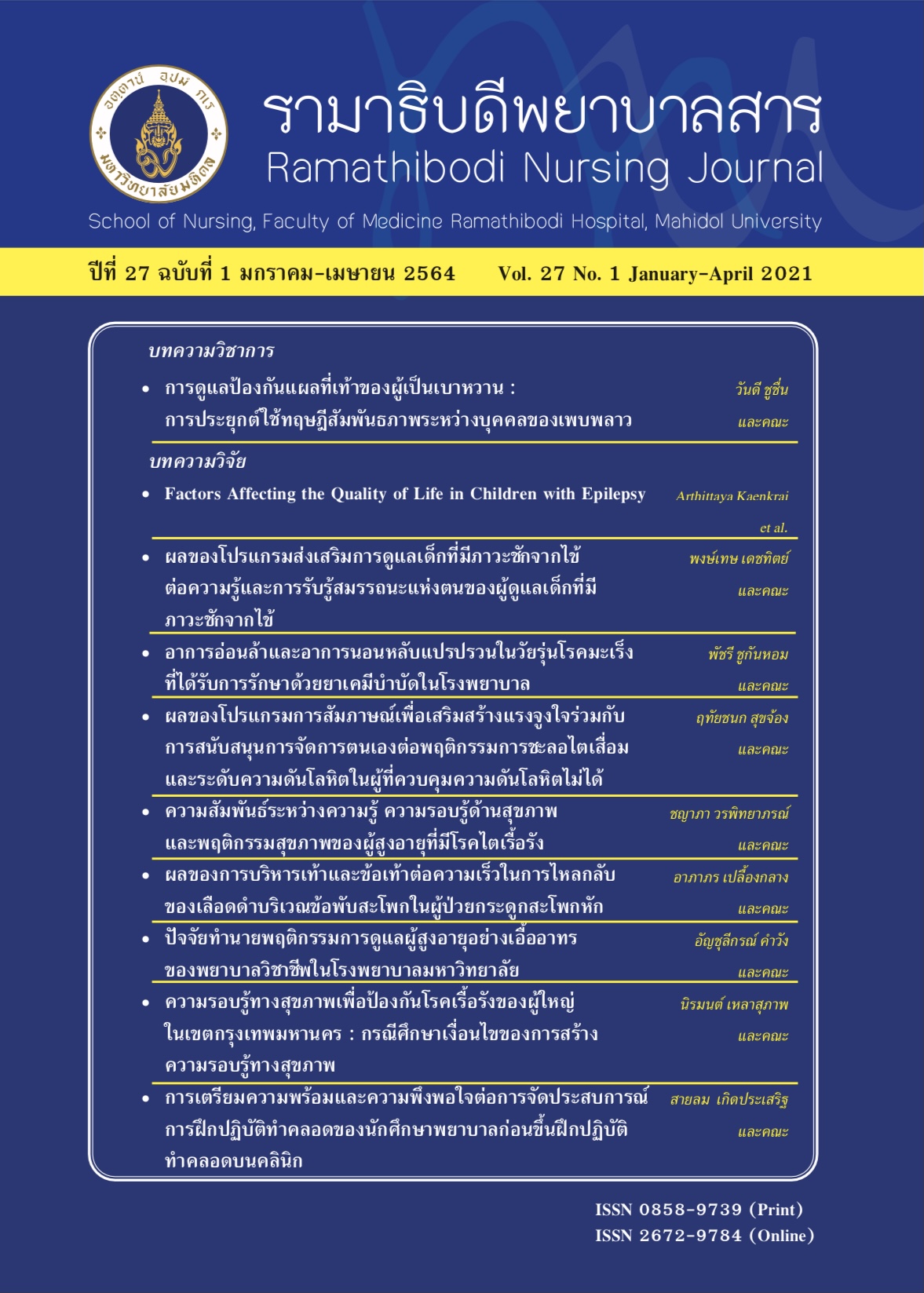Factors Affecting the Quality of Life in Children with Epilepsy
Main Article Content
Abstract
Abstract:
Health-related quality of life (HRQOL) is considered as an important clinical outcome, especially in children with chronic illnesses. This predictive, descriptive study aimed at investigating the factors affecting health-related quality of life in children with epilepsy, including epilepsy severity, comorbidity, and family functioning. The sample,which consisted of 90 caregivers of children with epilepsy between the ages of 4 to 15 years, was recruited from the pediatric neurological out-patient clinic and in-patient wards at Prasat Neurological Institute, and Ramathibodi Hospital located in Bangkok,Thailand. Data were collected during June-August 2019. A set of questionnaires was used including demographic characteristics and medical record of illness data of children with epilepsy, the Chulalongkorn Family Inventory (CFI), and the Quality of Life in Childhood Epilepsy (QOLCE-16). Data analysis used descriptive statistics, Pearson’s product-moment correlation coefficient, and multiple regression analysis. The findings revealed that epilepsy severity, comorbidity, and family functioning could jointly predict the overall QOLCE, and accounted for 28.40% of the variance in the overall quality of life of children with epilepsy. Results of this study would help nurses and healthcare professionals provide adequate support and further design the intervention to improve the quality of life among children with epilepsy.
Keywords: Predictive factors, Health-related quality of life, Childhood epilepsy
Article Details
บทความ ข้อมูล เนื้อหา รูปภาพ ฯลฯ ที่ได้รับการตีพิมพ์ในรามาธิบดีพยาบาลสาร ถือเป็นลิขสิทธิ์ของวารสาร หากบุคคลหรือหน่วยงานใดต้องการนำทั้งหมดหรือส่วนหนึ่งส่วนใดไปเผยแพร่หรือเพื่อกระทำการใด ใด จะต้องได้รับอนุญาตเป็นลายลักษณ์อักษรจากรามาธิบดีพยาบาลสารก่อนเท่านั้น
References
Aaberg KM, Gunnes N, Bakken IJ, Søraas CL, Berntsen A, Magnus P, et al. Incidence and prevalence of childhood epilepsy: A nationwide cohort study. Pediatrics. 2017;139(5):e20163908.
Camfield P, Camfield C. Incidence, prevalence and aetiology of seizures and epilepsy in children. Epileptic
Disord. 2015;17(2):117-23.
Russ SA, Larson K, Halfon N. A national profile of childhood epilepsy and seizure disorder. Pediatrics.
;129(2):256-64.
Asawavichienjinda T, Sitthi-Amorn C, Tanyanont W.Prevalence of epilepsy in rural Thailand: a populationbased
study. J Med Assoc Thai. 2002;85(10):1066-73.
Modi AC, Ingerski LM, Rausch JR, Glauser TA. Treatment factors affecting longitudinal quality of life in new onset pediatric epilepsy. J Pediatr Psychol. 2011;36(4):466-75.
Testa MA, Simonson DC. Assessment of quality-of-life outcomes. N Engl J Med. 1996;334(13):835-40.
Cramer JA. Principles of health-related quality of life:assessment in clinical trials. Epilepsia. 2002;43(9):1084-
Goodwin SW, Ferro MA, Speechley KN. Development and assessment of the Quality of Life in Childhood Epilepsy Questionnaire (QOLCE-16). Epilepsia. 2018;59(3):668-78.
Haneef Z, Grant ML, Valencia I, Hobdell EF, KothareSV, Legido A, et al. Correlation between child and parental
perceptions of health-related quality of life in epilepsy using the PedsQL. v4. 0 measurement model. Epileptic
Disord. 2010;12(4):275-82.
Ramsey RR, Loiselle K, Rausch JR, Harrison J, Modi AC.Predictors of trajectories of epilepsy-specific quality of
life among children newly diagnosed with epilepsy.Epilepsy Behav. 2016;57 (Pt A): 202-10.
Schachter SC. Epilepsy quality of life and cost of care.Epilepsy Behav. 2000;1(2):120-7.
Ronen GM, Streiner DL, Rosenbaum P. Health-related quality of life in childhood epilepsy: moving beyond’
seizure control with minimal adverse effects. Health and Quality of life Outcomes. 2003;1(1):36.
Ferro MA. Risk factors for health-related quality of life in children with epilepsy: a meta-analysis. Epilepsia.
;55(11):1722-31.
Mendes TP, Crespo CA, Austin JK. Family cohesion, stigma, and quality of life in dyads of children with epilepsy and their parents. J Pediatr Psychol. 2017;42(6):689-99.
Puka K, Ferro MA, Anderson KK, Speechley KN. Healthrelated quality of life in mothers of children with epilepsy:10 years after diagnosis. Qual Life Res. 2018:969-77.
Lach LM, Ronen GM, Rosenbaum PL, Cunningham C,Boyle MH, Bowman S, et al. Health-related quality of
life in youth with epilepsy: theoretical model for clinicians and researchers. Part I: the role of epilepsy and comorbidity.Qual Life Res. 2006;15(7):1161-71.
Bompori E, Niakas D, Nakou I, Siamopoulou-Mavridou A, Tzoufi MS. Comparative study of the health-related
quality of life of children with epilepsy and their parents.Epilepsy Behav. 2014;41:11-7.
Epstein NB, Baldwin LM, Bishop DS. The McMaster family assessment device. J Marital Fam Ther.
;9(2):171-80.
Sajobi TT, Wang M, Ferro MA, Brobbey A, Goodwin S,Speechley KN, et al. Multivariate trajectories across
multiple domains of health-related quality of life in children with new-onset epilepsy. Epilepsy Behav.
;75:72-8.
Cohen J. A power primer. Psychol Bull. 1992;112(1):155-159.
Austin JK, Dunn DW, Huster GA. Childhood epilepsy and asthma: changes in behavior problems related to gender and change in condition severity. Epilepsia.2000;41(5):615-23.
Räty LK, Söderfeldt BA, Larsson G, Larsson BMW. The relationship between illness severity, sociodemographic
factors, general self-concept, and illness-specific attitude in Swedish adolescents with epilepsy. Seizure.
;13(6):375-82.
Trangkasombat U. Family therapy and family counseling.Bangkok: Family Research and Development Center;
Goodwin SW, Ferro MA, Speechley KN. Measurement equivalence of the short-form Quality of Life in Childhood Epilepsy Questionnaire (QOLCE-16). Epilepsy Behav.2019;90:142-7.
Thrasher C, Grossmann T. Children’s emotion perception in context: the role of caregiver touch and relationship quality. Emotion; 2019.
Cianchetti C, Messina P, Pupillo E, Crichiutti G, Baglietto MG, Veggiotti P, et al. The perceived burden of epilepsy:impact on the quality of life of children and adolescents and their families. Seizure. 2015;24:93-101.
Ferrer F, Vilaseca R, Olmos JG. Positive perceptions and perceived control in families with children with intellectual disabilities: relationship to family quality of life. Qual Quant. 2017;51(2):903-18.


